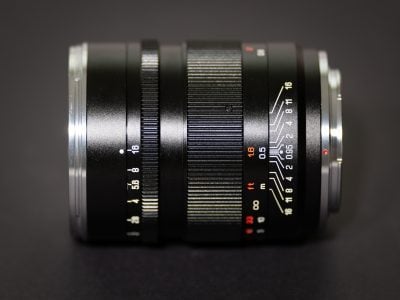Zhongyi Mitakon Speedmaster 50mm f0.95 III review
-
-
Written by Thomas
Quality
Testing: Longitudinal Chromatic Aberration and focus shift
Lenses with focal ratios of f2.8 or larger are often prone to longitudinal color aberrations (loCA, a.k.a. “axial color” or “bokeh CA”). These show up as magenta coloration in the foreground and greenish hues in the background and are not easily corrected in post-processing. The loCA of the Mitakon 50mm f0.95 III shows a little less green in the background but a pretty intense bluish/purple coloration in the foreground:
Mitakon 50mm f0.95 III Longitudinal Chromatic Aberration (loCA)
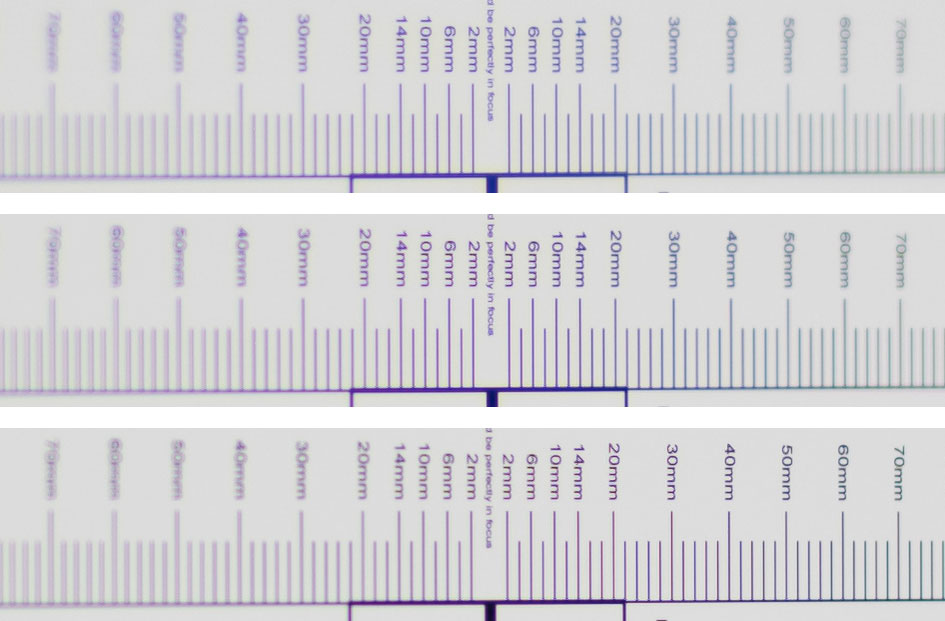
100% crops, from top to bottom: f0.95, f1.4, f2.0; left = foreground, right = background
The test also revealed that there is a bit of focus shift between f1.4 (2nd crop) and f2.0 (3rd crop): See e.g. how the 14mm mark on the left becomes less sharp when stopped down. For comparison have a look at the Nikon Z 58mm f0.95 S Noct, or the Nikon 58mm f1.4G and Zeiss Otus 55mm f1.4 (both shown at f1.4/f2.0/f2.8).
The following real life shot shows that the Mitakon produces strong purple and green haloing around high-contrast edges eating heavily into the darker areas of the image:

Above: Mitakon 50mm f0.95 III at f0.95; 100% crop; click image to access 4k version
This effect does not abate when stopped down to f1.4.
Sharpness and contrast
Let’s see how the Zhongyi’s Mitakon 50mm f0.95 III performs in the sharpness test based on Siemens-stars. Processing was done in Lightroom 8/CRAW 11 from RAW to Adobe Color profile. Noise-reduction is set to 0, sharpening to 50/0.5/36/10, with no extra tone, color, or saturation adjustment. White-balance was adjusted to a neutral white and I did some exposure compensation to make the brightness of all crops match. So you will not see light fall-off in the corners. Removal of lateral color aberrations is ON, longitudinal CA are not corrected.
The following 100% crops show the Mitakon 50mm f0.95 III from f0.95 down to f8 compared to the Nikon Z 58mm f0.95 S Noct, Zeiss Otus 55mm f1.4, Nikon 58mm f1.4G. No lens profiles were applied to the Otus and the Mitakon.
Mitakon 50mm f0.95 III compared; 100% crop from center, APS-C-corner, FF-corner

Above: Mitakon 50mm f0.95 III at f0.95

Above: Nikon Z 58mm f0.95 S Noct at f0.95; also available at f1.4, f1.8, f2.0, f2.8, f4.0, f5.6, f8.0, f11
Wide open the Mitakon is miles behind the Nikon Z Noct – which is not surprising considering the difference in price. The Mitakon shows quite some detail up to 5mm image height but becomes clearly soft from 8mm onward.
Let’s see how the Mitakon compares to other lenses at f1.4:

Above: Mitakon 50mm f0.95 III at f1.4

Above: Nikon Z 58mm f0.95 S Noct at f1.4

Above: Zeiss Otus 55mm f1.4 at f1.4; also available at f1.8, f2.0, f2.8, f4.0, f5.6, f8.0, f11

Above: Nikon 58mm f1.4G at f1.4; also available at f1.8, f2.0, f2.8, f4.0, f5.6, f8.0, f11
At f1.4 the center of the Mitakon is sharper than from Nikon’s 58mm f1.4G but behind the Nikon Z Noct or the Zeiss Otus. But the APS-C-corner and FF-corner of the Mitakon did not profit much from stopping down and is still mushy.
Now let’s see how the Mitakon 50mm f0.95 III develops when stopped further down:

Above: Mitakon 50mm f0.95 III at f2.0

Above: Mitakon 50mm f0.95 III at f2.8

Above: Mitakon 50mm f0.95 III at f4.0

Above: Mitakon 50mm f0.95 III at f5.6

Above: Mitakon 50mm f0.95 III at f8.0
At f2.0 the APS-C-corner begins to sharpen up and gets quite good at f2.8. With every additional stop down the radius of good sharpness spreads towards the FF-corner until at f8.0 Zhongyi’s Mitakon 50mm f0.95 III lens produces pretty even sharpness across a full-frame sensor.
Performance at long distances
The Siemens-star test-targets are shot at a distance of 45x focal length (i.e. at around 2.3m for 50mm focal length). But performance of lenses also depends on the shooting distance. Therefore I present another series of test-shots of a city around 1 km away. Processing was done in Lightroom 8/CRAW 11 from RAW to Adobe Color profile with no lens-profile applied. Noise-reduction is set to 0, sharpening to 50/0.5/36/10, with no extra tone, color, or saturation adjustment. I used manual focus at the largest aperture and did not change focus for other apertures. All shots were made at ISO 64 and VR switched off.
The main image shows the complete scene wide open to give you an impression of the angle of view and to judge vignetting. You can access the respective shots up to f11 via the links beneath the main image. Following the main image are 100% crops from the Mitakon 50mm f0.95 III from f0.95 down to f8 compared to the Nikon Z 58mm f0.95 S Noct, Nikon 58mm f1.4G, and Zeiss Otus 55mm f1.4. The first three lenses were shot on the same day only minutes apart. The Otus was shot another day. No lens profiles were applied to the large original images from the Otus and the Mitakon but I applied vignette control to the crops from the Otus to make the brightness match. Please respect our copyright and only use those images for personal use.
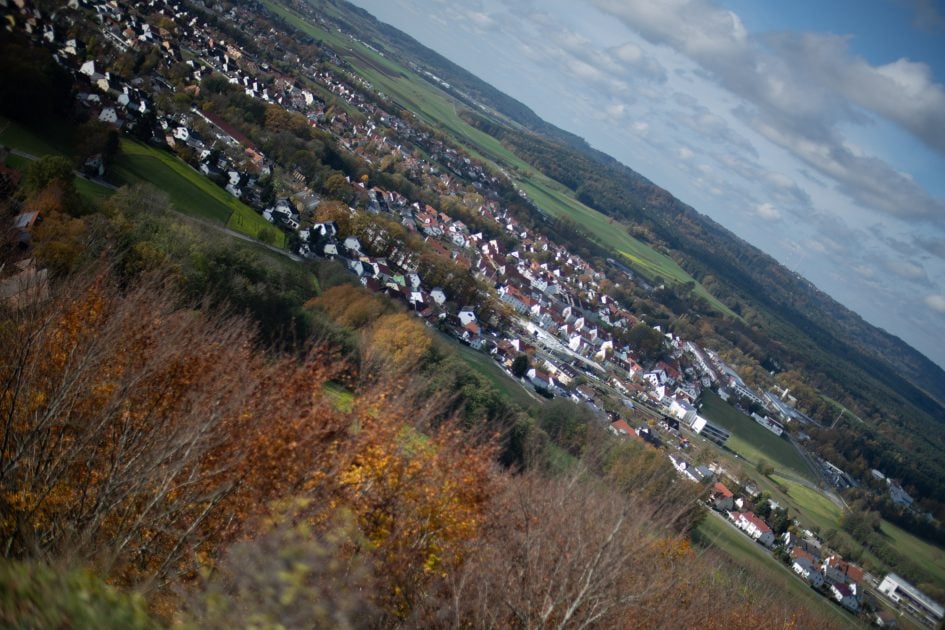
Above: Mitakon 50mm f0.95 III at f0.95; click image for 4k version

Above: Mitakon 50mm f0.95 III at f0.95; click image for 4k version, also available as large original at f0.95, f1.4, f2.0, f2.8, f4.0, f5.6, f8.0

Above: Nikon Z 58mm f0.95 S Noct at f0.95; click image for 4k version, also available as large original at f0.95, f1.2, f1.4, f1.8, f2.0, f2.8, f4.0, f5.6, f8.0, f11
Purple halos show prominently in the center of the Mitakon but there is quite some detail to be seen through the haze produced by the halos. But beginning well within the APS-C image-circle the Mitakon starts to become visibly softer until it looks outright fuzzy in the FF-corner.
Let’s see how the Mitakon compares to other lenses at f1.4:

Above: Mitakon 50mm f0.95 III at f1.4

Above: Nikon Z 58mm f0.95 S Noct at f1.4

Above: Zeiss Otus 55mm f1.4 at f1.4; click image for 4k version, also available as large original at f1.4, f1.8, f2.0, f2.8, f4.0, f5.6, f8.0, f11

Above: Nikon 58mm f1.4G at f1.4; click image for 4k version, also available as large original at f1.4, f1.8, f2.0, f2.8, f4.0, f5.6, f8.0, f11
Stopping down to f1.4 reduces the haloing of the Mitakon considerably and the lens produces a very sharp center better than from Nikon’s 58mm f1.4G. But outside the center the Mitakon is the softest of the four lenses compared here.
Now let’s see how the Mitakon 50mm f0.95 III develops when stopped further down:

Above: Mitakon 50mm f0.95 III at f2.0

Above: Mitakon 50mm f0.95 III at f2.8

Above: Mitakon 50mm f0.95 III at f4.0

Above: Mitakon 50mm f0.95 III at f5.6

Above: Mitakon 50mm f0.95 III at f8.0
The center of the Mitakon 50mm f0.95 III becomes very sharp at f2.0, the APS-C-corner sharpens up nicely at f4.0, and the FF-corner is very usable at f5.6 except for the last millimeter.
Vignetting, transmission, and distortions
To make it easier to see light fall-off in the corners of a full-frame sensor I’ve arranged a series of three shots with the Mitakon 50mm f0.95 III at different apertures. All images were developed to the same brightness in the center and the Adobe lens profile applied in the second row. This lifts the extreme corners by about 1/3 EV at f0.95:
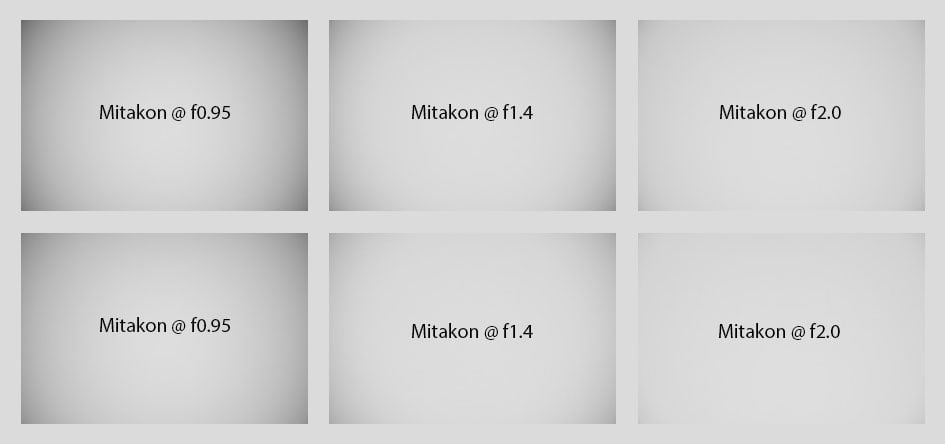
Above: Mitakon 50mm f0.95 III at f0.95, f1.4, f2.0; without lens profile (top), with Adobe lens profile (bottom)
With the lens profile applied the Mitakon shows a negligible amount of vignetting at f2.0.
While shooting the Mitakon and the Nikon Z Noct under comparable conditions I observed the Mitakon needing longer exposure times. Which indicates that the transmission of light is a bit lower on the Mitakon than on the Z-Noct. To find out more about any differences in transmission between both lenses I set up some test-shots at f0.95 under controlled conditions with identical lighting using shutter speeds of 1/400 sec, 1/500 sec, and 1/640 sec. Here is what I got after adjusting white-balance to make both lenses comparable and cropping from the center of the images to avoid light falloff:
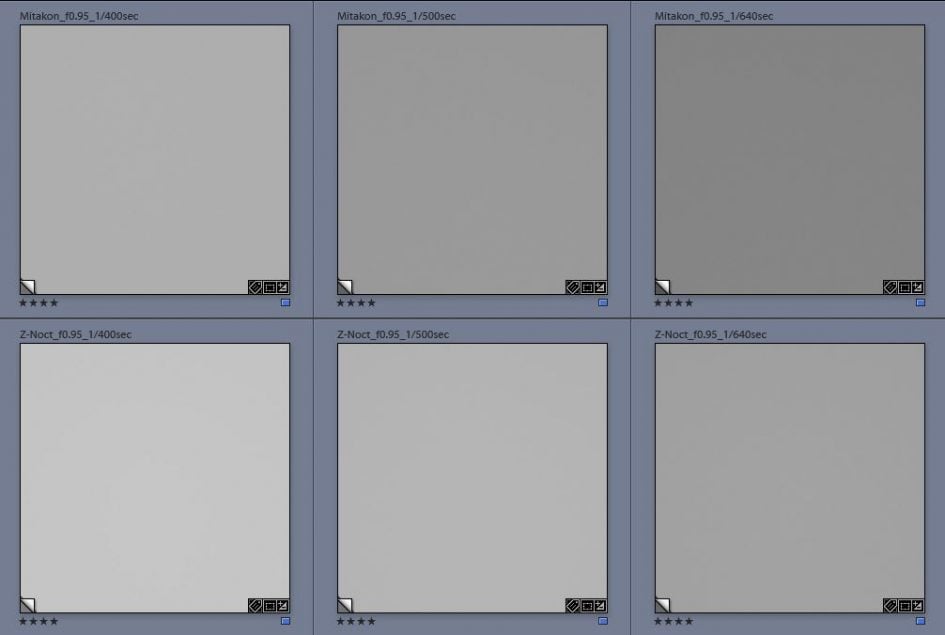
Above: Mitakon 50mm f0.95 III (top) vs. Nikon Z 58mm f0.95 S Noct (bottom) at f0.95, ISO 64, crop from the center
The Mitakon at 1/400 sec is 1/10 EV darker than the Z-Noct at 1/500 sec and 2/10 EV brighter than the Z-Noct at 1/640 sec. This means that the Mitakon transmits -0.43 EV less light than the Z-Noct – or the other way around: The Z-Noct is almost 1/2 Stop brighter than the Mitakon although having the same nominal focal ratio. The reasons probably having to do with better coating and higher quality glas.
Regarding distortions: The Mitakon 50mm f0.95 III has some visible barrel distortions but they are pretty well-corrected through Adobe’s lens profile as you can see in the examples at the end of the samples page. Only the outer 10% retain a slight curve unless you push the slider in Lightroom to 150%.
Rendering of point-light sources at night-shots
Night-shots pose a different challenge for lenses as the contrast is even higher than under bright sun and point-light sources can reveal some weaknesses such as coma, haloing and colour-aberrations that do not show up as prominently in other test-shots. The 100% crops below the main image show the effect of coma in the FF-corner of the Mitakon 50mm f0.95 III and the other lenses at various apertures:
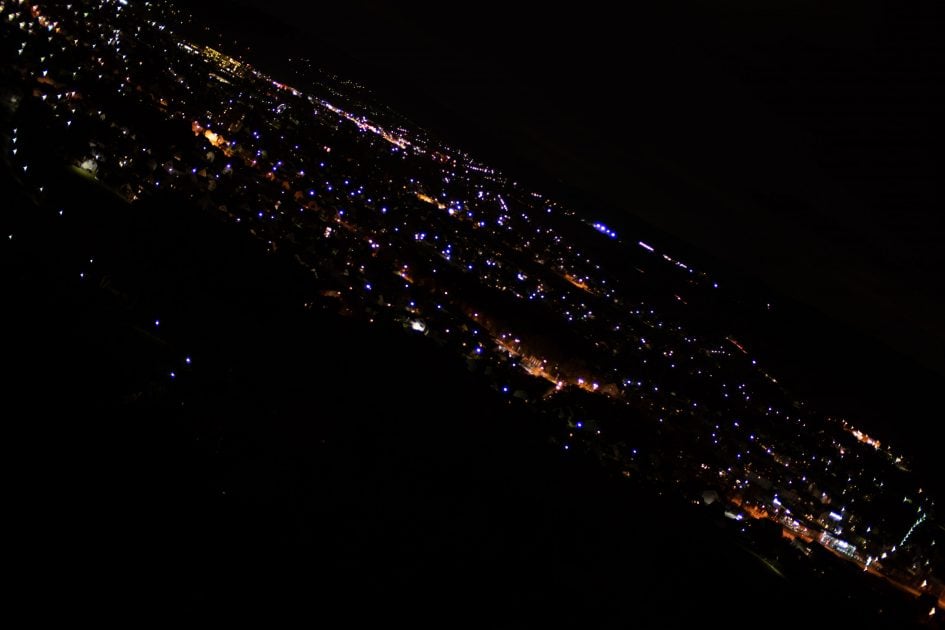
Above: Mitakon 50mm f0.95 III at f0.95; click image for 4k version, also available as large original at f0.95, f1.4, f2.0, f2.8, f4.0, f5.6, f8.0

Above: Mitakon 50mm f0.95 III; 100% crops from the FX-corner at f0.95 (left), f1.4 (middle), f2.0 (right)

Above: Nikon Z 58mm f0.95 S Noct; 100% crops from the FX-corner at f0.95 (left), f1.4 (middle), f2.0 (right)

Above: Zeiss Otus 55mm f1.4; 100% crops from the FF-corner at f1.4 (left), f2.0 (middle), f2.8 (right)

Above: Nikon 58mm f1.4G; 100% crops from the FX-corner at f1.4 (left), f2.0 (middle), f2.8 (right)
The Mitakon 50mm f0.95 III produces the classical coma flare up to f1.4. In that respect it is comparable to the Nikon 58mm f1.4G. The Nikon Z 58mm f0.95 S Noct and the Zeiss Otus 55mm f1.4 show much better controlled coma.
Halos also show prominently in these night-shots from the Mitakon. Have a look at the following crops from the center:

Above: Mitakon 50mm f0.95 III; 100% crops from the center at f0.95 (left), f1.4 (middle), f2.0 (right)
Rendering of out-of-focus point-light sources
This test is for the rendering of point-light sources in an out-of-focus background. The circle of confusion that is produced by this test is pretty indicative of Bokeh performance (in the background) and light fall-off. Ideally the out-of-focus image of the point-light is evenly lit and perfectly circular, with no “onion-rings”, and without coloration. Large aperture lenses normally produce an effect known as “cat’s eye” the further away from the optical axis the point-light is projected. This is due to optical vignetting in the lens barrel when light enters the lens from an angle.
The Mitakon 50mm f0.95 III is first, followed by the alternatives.
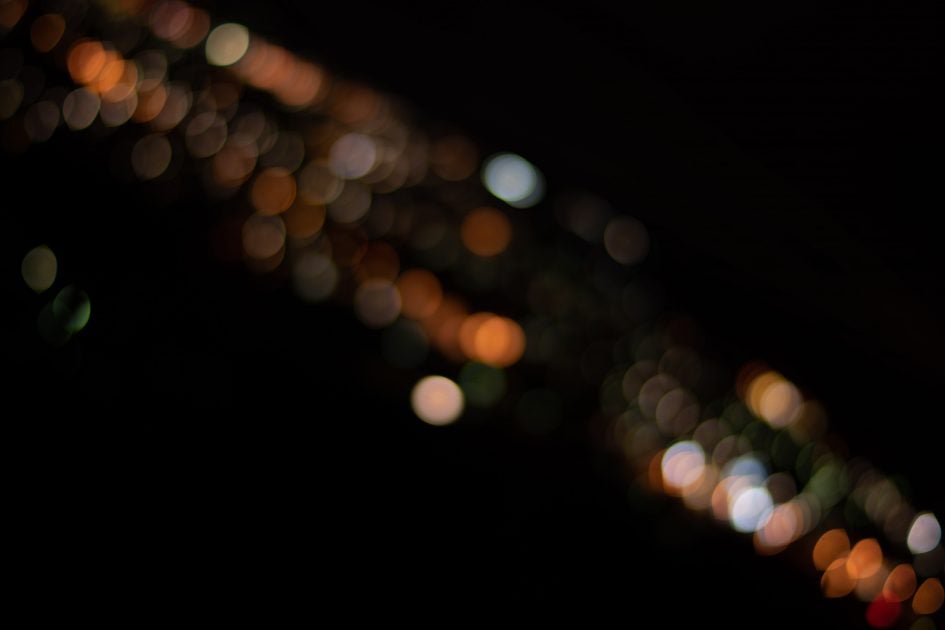
Above: Mitakon 50mm f0.95 III at f0.95; click image for 4k version

Above: Mitakon 50mm f0.95 III at f0.95; 44% crops from center, APS-C-corner, FF-corner; click image for 4k version, also available as large original at f0.95, f1.4, f2.0, f2.8, f4.0, f5.6, f8.0

Above: Nikon Z 58mm f0.95 S Noct at f0.95; 44% crops from center, APS-C-corner, FF-corner; click image for 4k version, also available as large original at f0.95, f1.2, f1.4, f1.8, f2.0, f2.8, f4.0, f5.6, f8.0

Above: Zeiss Otus 55mm f1.4 at f1.4; 44% crops from center, APS-C-corner, FF-corner; click image for 4k version, also available as large original at f1.4, f1.8, f2.0, f2.8, f4.0, f5.6, f8.0

Above: Nikon 58mm f1.4G at f1.4; 44% crops from center, APS-C-corner, FF-corner; click image for 4k version, also available as large original at f1.4, f1.8, f2.0, f2.8, f4.0, f5.6, f8.0
The diameter of the Bokeh balls in the center is determined by the entrance pupil of the lens. So it’s no surprise that at their respective largest aperture the Nikon Z 58mm f0.95 S Noct with its 16% longer focal length has a slight advantage over the Mitakon 50mm f0.95 III. The Nikon 58mm f1.4G comes third place followed by the 55mm f1.4 Otus. The most noticeable feature of the Mitakon is the under-corrected spherical aberrations which lead to a very soft border of the central Bokeh balls. Onion rings or texture within the Bokeh balls are almost a non-issue with only the 58mm f1.4G Nikkor showing slight rings. Outlining may be more of a distractor but even with the Zeiss Otus it is relatively mild. Cat’s eyes towards the corners are most prominent with the Zeiss Otus and the Z Noct.
One less pleasing aspect of the Mitakon’s Bokeh is the effect its straight aperture blades have on the Bokeh balls when stopped down. That looks wrong already at f1.4:

Above: Mitakon 50mm f0.95 III at f1.4; 44% crops from center, APS-C-corner, FF-corner; click image for 4k version
Now let’s see how this analysis of out-of-focus point-light sources translates into Bokeh-performance shooting a book-shelf.
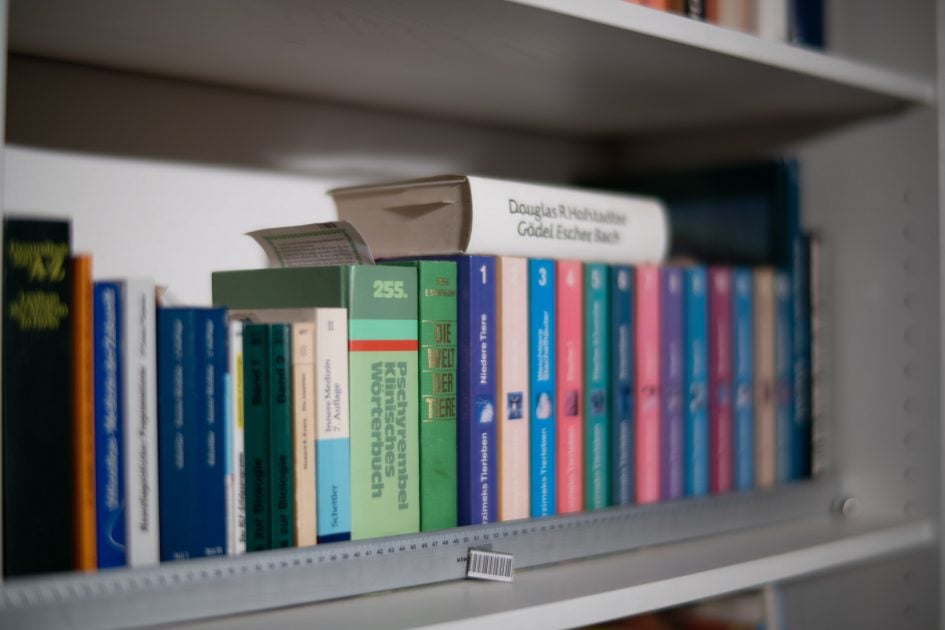
Above: Mitakon 50mm f0.95 III at f0.95; click image for 4k version

Above: Mitakon 50mm f0.95 III at f0.95; 44% crops from foreground, middle-ground, background; click image for 4k version, also available as large original at f0.95, f1.4, f2.0, f2.8, f4.0, f5.6

Above: Nikon Z 58mm f0.95 S Noct at f0.95; 44% crops from foreground, middle-ground, background; click image for 4k version, also available as large original at f0.95, f1.2, f1.4, f1.8, f2.0, f2.8, f4.0, f5.6

Above: Zeiss Otus 55mm f1.4 at f1.4; 44% crops from foreground, middle-ground, background; click image for 4k version, also available as large original at f1.4, f1.8, f2.0, f2.8, f4.0, f5.6

Above: Nikon 58mm f1.4G at f1.4; 44% crops from foreground, middle-ground, background; click image for 4k version, also available as large original at f1.4, f1.8, f2.0, f2.8, f4.0, f5.6
The f0.95 lenses take the lead here with the Noct besting the Mitakon with a smoother transition zone in the middle-ground and a much better foreground blur. The Nikon 58mm f1.4G suffers from a nervous background, a pretty ugly foreground plus longitudinal CA creating greenish coloration in the transition zone.
Portrait performance
50mm focal length may not be the classical choice for portraits on a full-frame camera but when you can get a bit closer it is still good for upper body or full body shots. The following shots were all done from the same position/distance so perspective does not change between shots. There is slightly different framing from different effective focal length at the shooting distances and there are also some slight focus-differences which inevitably occur when you shoot a living, breathing subject. All images were developed from RAW to Adobe Color profile with identical white balance.
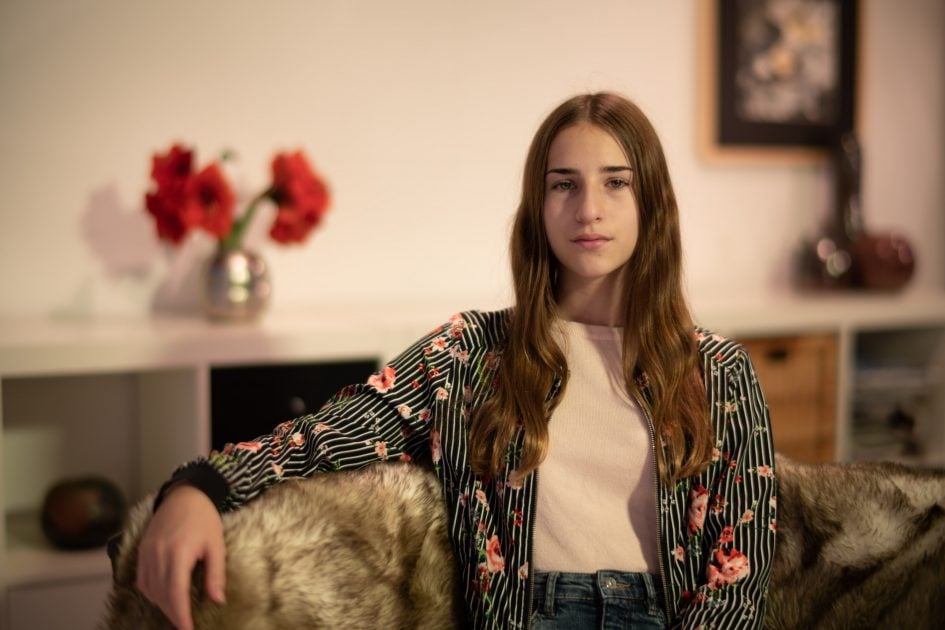
Above: Mitakon 50mm f0.95 III at f0.95; click image for 4k version

Above: Mitakon 50mm f0.95 III at f0.95, 50% crop; click image to view 100% crop, also available as large original at f0.95, f1.4, f2.0, f2.8

Above: Nikon Z 58mm f0.95 S Noct at f0.95 50% crop; click image to view 100% crop, also available as large original at f0.95, f1.2, f1.4, f1.8, f2.0

Above: Zeiss Otus 55mm f1.4 at f1.4, 50% crop; click image to view 100% crop, also available as large original at f1.4, f1.8, f2.0, f2.8

Above: Nikon 58mm f1.4G at f1.4, 50% crop; click image to view 100% crop, also available as large original at f1.4, f1.8, f2.0, f2.8
I think the Nikon Z Noct renders the most beautiful image here: Sharp where it should be with a smooth, soft transition and a nicely blurred background. The Mitakon simply does not produce the “pop” as it is too soft at f0.95. Of the other lenses the Nikon 58mm f1.4G also produces a softer focal plane.
Now, many differences in the above samples are results of the different apertures. So the question is: How big are the differences when all lenses are shot at the same aperture. The following crops are all from the respective shots at f2.0:

Above: Mitakon 50mm f0.95 III at f2.0, 50% crop; click image to view 100% crop

Above: Nikon Z 58mm f0.95 S Noct at f2.0 50% crop; click image to view 100% crop

Above: Zeiss Otus 55mm f1.4 at f2.0, 50% crop; click image to view 100% crop

Above: Nikon 58mm f1.4G at f2.0, 50% crop; click image to view 100% crop
Obviously all lenses become sharper now but the Mitakon and the Nikon 58mm f1.4G still lag a bit behind the other lenses visible even in 50% crops. That may surprise a bit as the Mitakon produces a very sharp center at f2.0 in my tests with the Siemens stars. But keep in mind that the eye of the girl is about 8mm off-center where sharpness of the Mitakon already starts to deteriorate.
Flare, glare, ghosting, and sun-stars
Catching a strong light-source shining directly into the lens is always a risky business: it could produce strange colorful ghost-images or reduce contrast considerably through flare and glare. The appearance of flare and ghosting depends on factors like the aperture and the angle of the light hitting the lens. So to judge the proclivity of the Mitakon 50mm f0.95 III for these artifacts I went through a series of well calculated shots against a strong light source to provoke glare and ghosting. The lens hood was mounted in all shots. Following is one of the more extreme example results. The little bright square inset in the upper left shows the respective area with an exposure compensation of +3 EV to make it easier to see which levels of black the lens renders at that point:
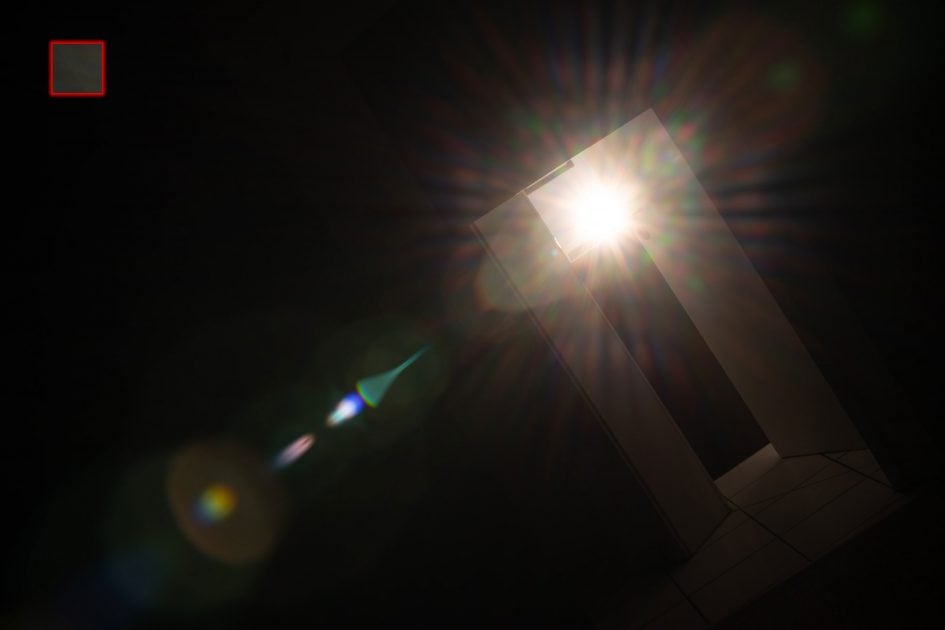
Above: Flare and ghosting. Strong light hitting the Mitakon 50mm f0.95 III at f11; click image for 4k version or here for +3 EV exposure compensation
Flare, glare, and ghosting is not so well controlled at f11. For comparison have a look at the Nikon Z 58mm f0.95 S Noct, Nikon 58mm f1.4G, and the Zeiss Otus 55mm f1.4 all shown at f11.
The Mitakon also produces a strong flare/glare when the light-source is just outside the corner:
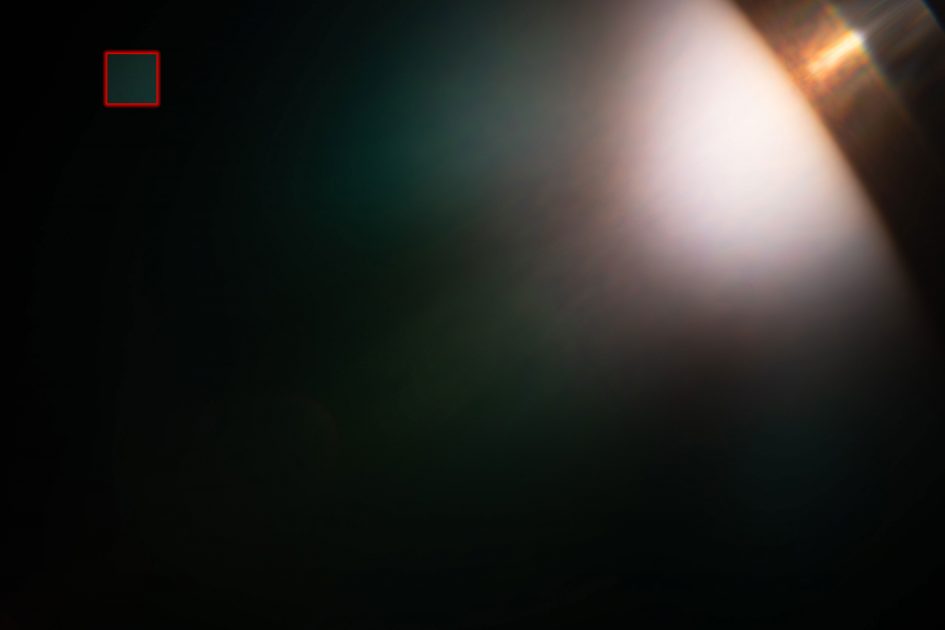
Above: Flare and ghosting. Strong light hitting the Mitakon 50mm f0.95 III at f11; click image for 4k version or here for +3 EV exposure compensation
All-in-all the Mitakon 50mm f0.95 III does not perform too well under adverse contra-light situations.
Regarding sunstars: Due to its straight aperture blades the Mitakon 50mm f0.95 III produces sunstars even at f2.8:

Above: Sunstars from the Mitakon 50mm f0.95 III at f2.8 (left) and f5.6 (right), 100% crops
Next check out my sample images!
Check prices on the Mitakon Speedmaster 50mm f0.95 III at Amazon, B&H or Adorama. Alternatively get yourself a copy of my In Camera book or treat me to a coffee! Thanks!



